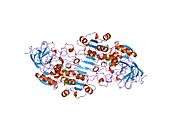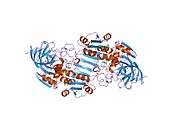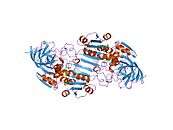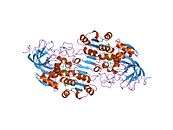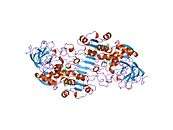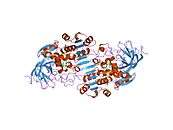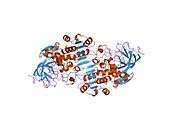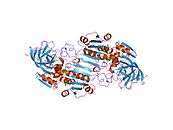ADH1A
Alcohol dehydrogenase 1A is an enzyme that in humans is encoded by the ADH1A gene.[2][3]
This gene encodes class I alcohol dehydrogenase, alpha subunit, which is a member of the alcohol dehydrogenase family. Members of this enzyme family metabolize a wide variety of substrates, including ethanol, retinol, other aliphatic alcohols, hydroxysteroids, and lipid peroxidation products. Class I alcohol dehydrogenase, consisting of several homo- and heterodimers of alpha, beta, and gamma subunits, exhibits high activity for ethanol oxidation and plays a major role in ethanol catabolism. Three genes encoding alpha, beta and gamma subunits are tandemly organized in a genomic segment as a gene cluster. This gene is monomorphic and predominant in fetal and infant livers, whereas the genes encoding beta and gamma subunits are polymorphic and strongly expressed in adult livers.[3]
References
External links
Further reading
- Lange LG, Sytkowski AJ, Vallee BL (1976). "Human liver alcohol dehydrogenase: purification, composition, and catalytic features". Biochemistry. 15 (21): 4687–93. doi:10.1021/bi00666a023. PMID 9982.
- van Ooij C, Snyder RC, Paeper BW, Duester G (1992). "Temporal expression of the human alcohol dehydrogenase gene family during liver development correlates with differential promoter activation by hepatocyte nuclear factor 1, CCAAT/enhancer-binding protein alpha, liver activator protein, and D-element-binding protein". Mol. Cell. Biol. 12 (7): 3023–31. PMC 364516
 . PMID 1620113.
. PMID 1620113.
- Stewart MJ, McBride MS, Winter LA, Duester G (1990). "Promoters for the human alcohol dehydrogenase genes ADH1, ADH2, and ADH3: interaction of CCAAT/enhancer-binding protein with elements flanking the ADH2 TATA box". Gene. 90 (2): 271–9. doi:10.1016/0378-1119(90)90190-3. PMID 2169444.
- Yasunami M, Kikuchi I, Sarapata D, Yoshida A (1990). "The human class I alcohol dehydrogenase gene cluster: three genes are tandemly organized in an 80-kb-long segment of the genome". Genomics. 7 (2): 152–8. doi:10.1016/0888-7543(90)90535-3. PMID 2347582.
- Tsukahara M, Yoshida A (1989). "Chromosomal assignment of the alcohol dehydrogenase cluster locus to human chromosome 4q21-23 by in situ hybridization". Genomics. 4 (2): 218–20. doi:10.1016/0888-7543(89)90304-2. PMID 2737681.
- Matsuo Y, Yokoyama S (1989). "Molecular structure of the human alcohol dehydrogenase 1 gene". FEBS Lett. 243 (1): 57–60. doi:10.1016/0014-5793(89)81217-7. PMID 2920825.
- Ikuta T, Szeto S, Yoshida A (1986). "Three human alcohol dehydrogenase subunits: cDNA structure and molecular and evolutionary divergence". Proc. Natl. Acad. Sci. U.S.A. 83 (3): 634–8. doi:10.1073/pnas.83.3.634. PMC 322918
 . PMID 2935875.
. PMID 2935875.
- von Bahr-Lindström H, Höög JO, Hedén LO, et al. (1986). "cDNA and protein structure for the alpha subunit of human liver alcohol dehydrogenase". Biochemistry. 25 (9): 2465–70. doi:10.1021/bi00357a026. PMID 3013304.
- Duester G, Farrés J, Felder MR, et al. (1999). "Recommended nomenclature for the vertebrate alcohol dehydrogenase gene family". Biochem. Pharmacol. 58 (3): 389–95. doi:10.1016/S0006-2952(99)00065-9. PMID 10424757.
- Rodriguez-Zavala JS, Weiner H (2002). "Structural aspects of aldehyde dehydrogenase that influence dimer-tetramer formation". Biochemistry. 41 (26): 8229–37. doi:10.1021/bi012081x. PMID 12081471.
- Sandberg M, Yasar U, Strömberg P, et al. (2003). "Oxidation of celecoxib by polymorphic cytochrome P450 2C9 and alcohol dehydrogenase". British Journal of Clinical Pharmacology. 54 (4): 423–9. doi:10.1046/j.1365-2125.2002.01660.x. PMC 1874434
 . PMID 12392591.
. PMID 12392591.
- Strausberg RL, Feingold EA, Grouse LH, et al. (2003). "Generation and initial analysis of more than 15,000 full-length human and mouse cDNA sequences". Proc. Natl. Acad. Sci. U.S.A. 99 (26): 16899–903. doi:10.1073/pnas.242603899. PMC 139241
 . PMID 12477932.
. PMID 12477932.
- Gerhard DS, Wagner L, Feingold EA, et al. (2004). "The Status, Quality, and Expansion of the NIH Full-Length cDNA Project: The Mammalian Gene Collection (MGC)". Genome Res. 14 (10B): 2121–7. doi:10.1101/gr.2596504. PMC 528928
 . PMID 15489334.
. PMID 15489334.
- Dannenberg LO, Chen HJ, Edenberg HJ (2006). "GATA-2 and HNF-3beta regulate the human alcohol dehydrogenase 1A (ADH1A) gene". DNA Cell Biol. 24 (9): 543–52. doi:10.1089/dna.2005.24.543. PMID 16153155.
- Jelski W, Chrostek L, Szmitkowski M (2007). "The activity of class I, II, III, and IV of alcohol dehydrogenase isoenzymes and aldehyde dehydrogenase in pancreatic cancer". Pancreas. 35 (2): 142–6. doi:10.1097/MPA.0b013e318053eae2. PMID 17632320.
PDB gallery |
|---|
|
-
1deh: CRYSTALLIZATION OF HUMAN BETA1 ALCOHOL DEHYDROGENASE (15 MG/ML) IN 50 MM SODIUM PHOSPHATE (PH 7.5), 2.0 MM NAD+ AND 1 MM 4-IODOPYRAZOLE AT 25 OC, 13% (W/V) PEG 8000
-
1hdx: THREE-DIMENSIONAL STRUCTURES OF THREE HUMAN ALCOHOL DEHYDROGENASE VARIANTS: CORRELATIONS WITH THEIR FUNCTIONAL DIFFERENCES
-
1hdy: THREE-DIMENSIONAL STRUCTURES OF THREE HUMAN ALCOHOL DEHYDROGENASE VARIANTS: CORRELATIONS WITH THEIR FUNCTIONAL DIFFERENCES
-
1hdz: THREE-DIMENSIONAL STRUCTURES OF THREE HUMAN ALCOHOL DEHYDROGENASE VARIANTS: CORRELATIONS WITH THEIR FUNCTIONAL DIFFERENCES
-
1hso: HUMAN ALPHA ALCOHOL DEHYDROGENASE (ADH1A)
-
1hsz: HUMAN BETA-1 ALCOHOL DEHYDROGENASE (ADH1B*1)
-
1ht0: HUMAN GAMMA-2 ALCOHOL DEHYDROGENSE
-
1htb: CRYSTALLIZATION OF HUMAN BETA3 ALCOHOL DEHYDROGENASE (10 MG/ML) IN 100 MM SODIUM PHOSPHATE (PH 7.5), 7.5 MM NAD+ AND 1 MM 4-IODOPYRAZOLE AT 25 C
-
1u3t: Crystal Structure of Human Alcohol Dehydrogenase Alpha-Alpha Isoform Complexed with N-Cyclopentyl-N-Cyclobutylformamide Determined to 2.5 Angstrom Resolution
-
1u3u: Crystal Structure of Human Alcohol Dehydrogenase Beta-1-Beta-1 Isoform Complexed with N-Benzylformamide Determined to 1.6 Angstrom Resolution
-
1u3v: Crystal Structure of Human Alcohol Dehydrogenase Beta-1-Beta-1 Isoform Complexed with N-Heptylformamide Determined to 1.65 Angstrom Resolution
-
1u3w: Crystal Structure of Human Alcohol Dehydrogenase Gamma-2-Gamma-2 Isoform Complexed with N-1-Methylheptylformamide Determined to 1.45 Angstrom Resolution
-
3hud: THE STRUCTURE OF HUMAN BETA 1 BETA 1 ALCOHOL DEHYDROGENASE: CATALYTIC EFFECTS OF NON-ACTIVE-SITE SUBSTITUTIONS
|
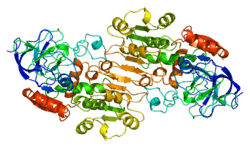
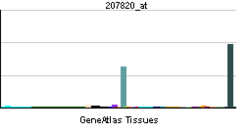
 . PMID 1620113.
. PMID 1620113. . PMID 2935875.
. PMID 2935875. . PMID 12392591.
. PMID 12392591. . PMID 12477932.
. PMID 12477932. . PMID 15489334.
. PMID 15489334.